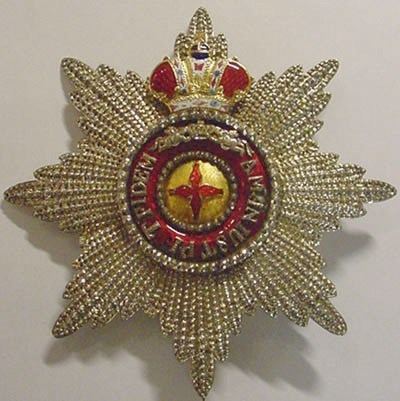Type Dynastic Order | Status Rarely constituted | |
 | ||
Ribbon Bright Red with thin Yellow stripes on either side. Motto Amantibus Justitiam, Pietatem, FidemTo those who Love Justice, Piety, and Fidelity | ||
The Order of Saint Anna (Russian: Орден Святой Анны; also "Order of Saint Ann" or "Order of Saint Anne") was established as a Holstein ducal and then Russian imperial order of chivalry established by Karl Friedrich, Duke of Holstein-Gottorp, on 14 February 1735, in honour of his wife Anna Petrovna, daughter of Peter the Great of Russia. The motto of the Order is "Amantibus Justitiam, Pietatem, Fidem" ("To those who love justice, piety, and fidelity"). Its festival day is 3 February (New Style, 16 February). Originally, the Order of Saint Anna was a dynastic order of knighthood; but between 1797 and 1917 it had dual status as a dynastic order and as a state order. The Head of the Imperial House of Russia always is Master of the imperial Order of Saint Anna. The Order of St. Anna continued to be awarded after the revolution by Grand Duke Kirill Vladimirovich, Grand Duke Vladimir Kirillovich, and Grand Duchess Maria Vladimirovna. Today, the Russian Imperial Order of St. Anna, awarded by Grand Duchess Maria Vladimirovna is recognized as a legitimate order of chivalry by ICOC and as a continuation of the pre-Revolutionary order, but not by some members of the Romanov Family Association.
Contents
Membership of the Order was awarded for a distinguished career in civil service or for valour and distinguished service in the military. The Order of Saint Anna entitled recipients of the first class to hereditary nobility, and recipients of lower classes to personal nobility. For military recipients, it was awarded with swords. It is now usually awarded for meritorious service to the Imperial House of Russia.
History
At first, the Order had but one class and was named the "Order of Anna". The statutes of the Order promulgated in 1735 established as the principal insignia a red-enameled gold cross, with an image of Saint Ann imposed upon the centre of the cross; the reverse bore the initials "A.I.P.F." (for "Anna Imperatoris Petri Filia": "Anna, Emperor Peter's daughter" in Latin). The same letters also abbreviate the Latin motto (as the letter "J" did not exist in Latin, "Iustitiam" was the original spelling of the word now rendered "Justitiam").
In 1742, Karl Peter Ulrich, Duke Karl Friedrich's son, was declared the Russian heir apparent. After arriving in Russia, he presented the Order to several courtiers. On 15 April 1797, his own son, Emperor Paul I of Russia, established the Order as part of the Imperial Russian system of honours and divided it into three classes, renaming it the "Order of Saint Anna". Emperor Alexander I added a fourth class in 1815.
Recipients of the Order of St. Andrew (including princes of the Imperial blood, who received it at baptism) simultaneously received the first class of the Order of Saint Anna. The Emperor himself was the hereditary chief of the Order.
The title of Chekhov's well-known story Anna on the Neck refers both to the Order and to the heroine.
Methods of Wear
The medal ribbon was red with narrow yellow edging.
A recipient of higher classes of the Order would not wear insignia of lower classes, unless he had also been awarded the fourth class (the insignia of which was borne on the hilt of a sword or other edged weapon).
